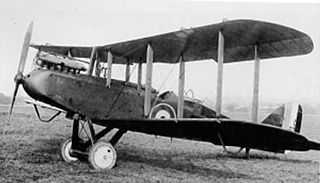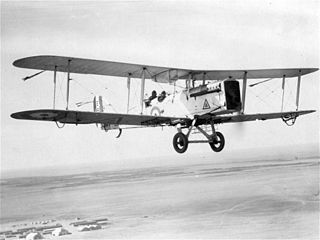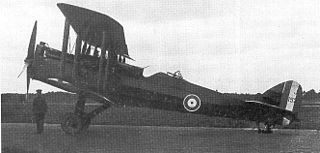The Aircraft Manufacturing Company Limited (Airco) was an early British aircraft manufacturer. Established during 1912, it grew rapidly during the First World War, referring to itself as the largest aircraft company in the world by 1918.

The de Havilland DH.89 Dragon Rapide is a 1930s short-haul biplane airliner developed and produced by British aircraft company de Havilland. Capable of accommodating 6–8 passengers, it proved an economical and durable craft, despite its outdated plywood construction.

The Airco DH.4 is a British two-seat biplane day bomber of the First World War. It was designed by Geoffrey de Havilland for Airco, and was the first British two-seat light day-bomber capable of defending itself.

The Airco DH.9 – also known after 1920 as the de Havilland DH.9 – is a British single-engined biplane bomber that was developed and deployed during the First World War.

The Airco DH.9A is a British single-engined light bomber that was designed and first used shortly before the end of the First World War. It was a development of the unsuccessful Airco DH.9 bomber, featuring a strengthened structure and, crucially, replacing the under-powered and unreliable inline 6-cylinder Siddeley Puma engine of the DH.9 with the American V-12 Liberty engine.

The de Havilland DH.90 Dragonfly is a 1930s British twin-engined luxury touring biplane built by the de Havilland Aircraft Company at Hatfield Aerodrome.

The Airco DH.1 was an early military biplane of typical "Farman" pattern flown by Britain's Royal Flying Corps during World War I. By the time the powerplant for which it was designed was sufficiently plentiful it was obsolete as an operational aircraft, and apart from a few examples sent to the Middle East it served as a trainer and Home Defence fighter.

The de Havilland DH.14 Okapi was a British two-seat day bomber of the 1910s built by de Havilland. The aircraft was designed as an Airco DH.4 and DH.9 replacement, but it never entered production.

The Airco DH.10 Amiens was a twin-engined heavy bomber designed and produced by the British aircraft manufacturer Airco. It performed the first nighttime air mail service in the world on 14-15 May 1919.

The de Havilland DH.29 Doncaster was a British long-range high-wing monoplane of the 1920s built by de Havilland.

Aircraft Transport and Travel Limited was a British airline formed during the First World War, a subsidiary of Airco. It was the first airline to operate a regular international flight.

The de Havilland DH.18 was a single-engined British biplane transport aircraft of the 1920s built by de Havilland.

The de Havilland DH.34 was a single engined British biplane airliner built by the de Havilland Aircraft Company in the 1920s. 12 were built, with the DH.34 serving with Imperial Airways and its predecessors for several years.

The de Havilland DH.51 is a 1920s British three-seat touring biplane built by de Havilland at Stag Lane Aerodrome, Edgware.

The Bristol Boarhound was a British army cooperation and liaison aircraft of the 1920s. It was a two-seat biplane with wings of equal span and a steel frame construction with fabric covering.
Daimler Airway was an airline subsidiary of the Birmingham Small Arms Company (BSA)'s Daimler Company. It was created to use some of the assets of the failed ventures Airco and its subsidiary, Aircraft Transport and Travel, which was acquired by BSA in February 1920.

The Airco DH.9C was a British passenger aircraft.

The Gloster A.S.31 Survey was a 1920s British photo-survey biplane developed by the Gloster Aircraft Company from the de Havilland DH.67 design project.

The de Havilland DH.15 Gazelle was an engine testbed for the B.H.P Atlantic engine, converted from a de Havilland DH.9A for flight trials in 1919–20. Only one was built.
British Air Transport – The Pioneering Days 1919–1934 is an 8.44-metre (27.7 ft)-long mural by William Kempster depicting, from left to right, a chronological sequence of events in the history of British aviation on the London to Paris route starting on the left with Hounslow Heath Aerodrome in 1919 and finishing on the right at Croydon Aerodrome in 1931. The most recent aircraft shown is the Short L.17 Scylla of 1934.


















